
To combat climate disruption, we must move toward a just transition of degrowth. In doing so, we need to find ways of prioritizing our needs in an ecological and equitable way.
Social Innovation creates “...new ideas (products, services and models) that simultaneously meet social needs and create new social relationships or collaborations. In other words, they are innovations that are both good for society and enhance society’s capacity to act.” – Open Book of Social Innovation (Social Innovation Generation, 2017)
Social innovation seeks to more successfully meet the needs of the most people. To best meet the needs of a community, an assessment of consumer needs is an integral part of social innovation. Minimalism helps in this process and I propose that it can also be part of corporate assessment and in a multi-stakeholder coordination of producers/workers and consumers. Much of marketing and corporate product innovation is focused on manufacturing a need. For example, was the Beanie Baby craze of 1995 meeting an unmet need that so many people lacked previously, or was it a manufactured need and people were convinced they need a Beanie Baby? Did it create lasting joy and fulfillment for consumers or was it a momentary craze? For the most effective social innovation, we may need to delve in deeper to what our needs as consumers are. Minimalism is the process of consumers self-reflecting on their needs and prioritizing for deeper fulfillment.
The Minimalists, author and podcast duo, Joshua Fields Millburn & Ryan Nicodemus, describe minimalism as such -
“Minimalism is a lifestyle that helps people question what things add value to their lives. By clearing the clutter from life’s path, we can all make room for the most important aspects of life: health, relationships, passion, growth, and contribution.” (Millburn & Nicodemus, 2018)
Author of Your Money or Your Life, Vicki Robin, uses the term “voluntary simplicity'' instead of minimalism.(Robin, 2008) Catholic Worker founder, Dorothy Day, has a similar concept of “holy poverty”.(Day, 1945) For Robin, Millburn, and Nicodemus, minimization is a process of prioritization and a simplification of life, which does not speak to how much wealth someone has, but what their priorities are. For Day, it is a matter of committing class suicide, if one does not live in poverty, and a moral requirement for us all to care for “the least of us” in biblical terms, while not retaining an economic privilege over those living in poverty.
Vicki Robin suggests a person handles their personal finances with an eye for if the expenses are in line with one's principles and what brings a person the most fulfillment. This includes, according to the process she outlines in her book, adding a plus, zero, or minus on a column for each expense in the ledger for if the expense was in alignment with the person's values and if the person felt a sense of fulfillment with the purchase (see attachment below). She then suggests that money saved through the reduction in spending be invested. With that investment, she proposes a goal of the return on investment superseding the person's now reduced cost of living. It's at this point that passive income is more than a person's expenses that it would be optional if the person decides to work at a job or not (see below).
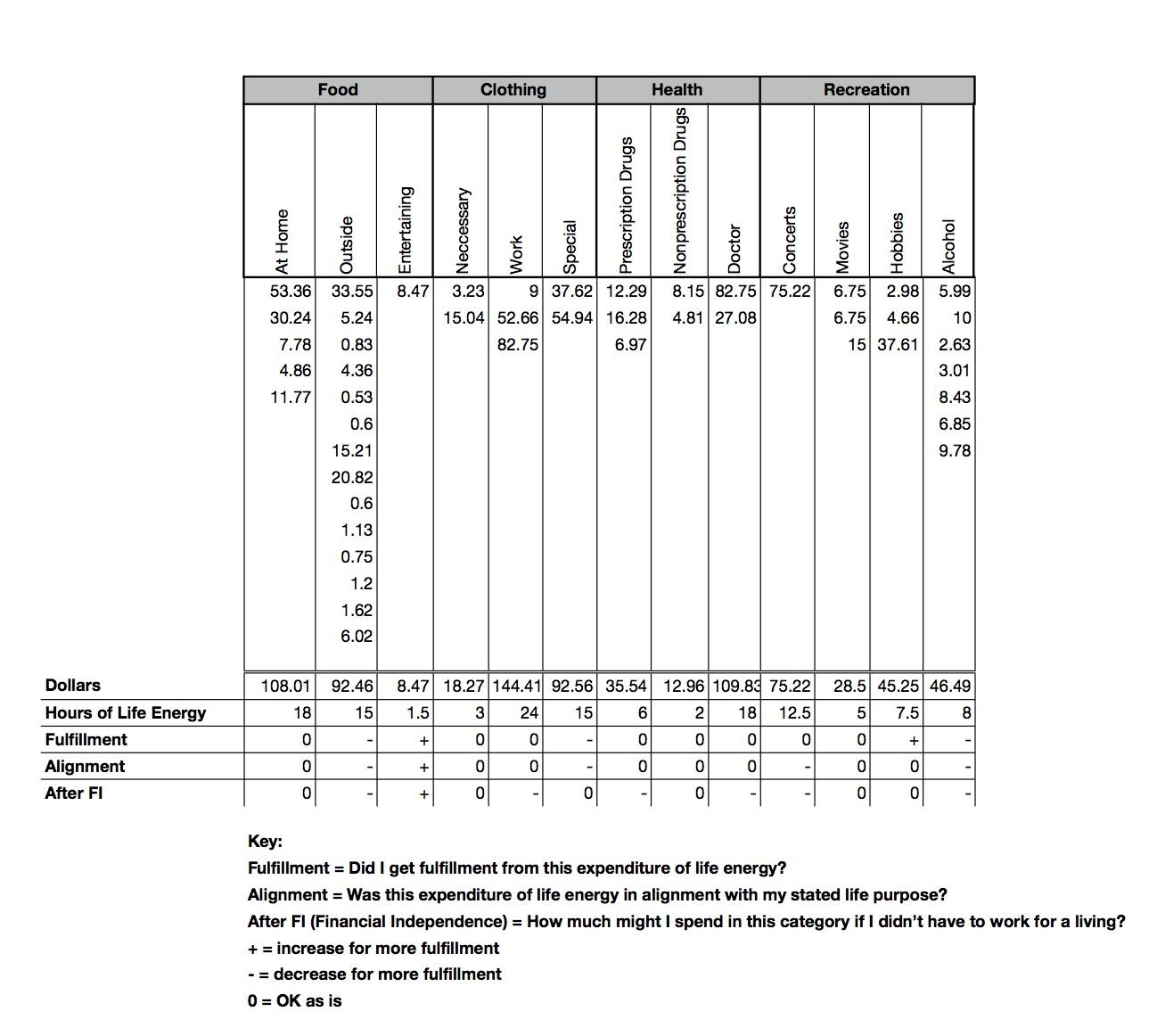
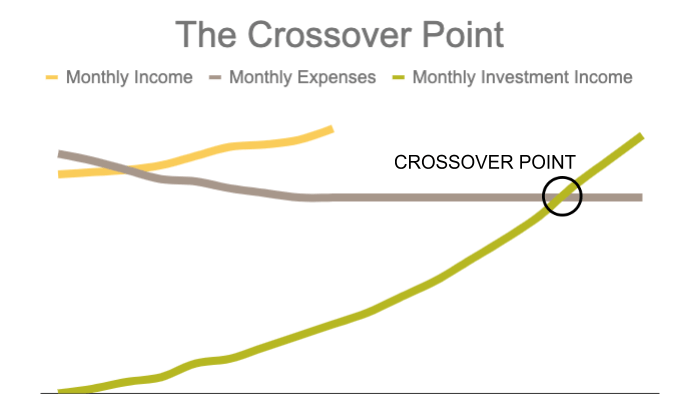
Marie Kondo, of the Netflix show Tidying Up with Marie Kondo recommends that people only keep possessions that bring them joy.(Wallis, 2019) The Minimalists suggest their readers and listeners ask themselves if a possession adds value to their life.
To move away from materialism and consumerism, minimalism provides a method for budgeting and prioritization. It provides a process for cutting the fat.
In Gandhian economics, liberation from oppressive institutions requires simple living to build Swadeshi, or self-reliance, along with an egalitarian distribution ethic of Sarvodaya, or well-being for all.(Shikhare, 2005) Similar to Vicki Robin's concept of taking money saved and investing, Gandhian economics, with a more communitarian approach, requires boycotting empire and investing in community self-determination. Similar to Dorothy Day, Gandhian economics also prioritizes equity and equality.
The self assessment process of minimalism applied as a group process then becomes participatory budgeting. If used in a multi-stakeholder cooperative, consumers can adequately describe their prioritized needs and producers/workers can most effectively meet those needs with the least amount of waste created.
Wanting more and more, despite a self-destructive nature behind it, is the definition of addiction to me. Our growth-based, extractive economy keeps chasing the next high and then having to recover from each crash afterwards with every boom and bust. We reward this sloppy and self-centered behavior under our current economic system. Dr. Gabor Mate, an expert in addiction, connects the existence of addiction to the trauma inflicted by capitalism:
"...if you look at the aboriginal population of North America; these people actually had potentially addictive substances available to them.
Not only were they available, they used them. There was, of course, tobacco, but there was no addiction. If the substances in themselves had been addictive, and if these people are genetically predisposed, either or, they should have been addicted. But there was no history of addiction prior to the coming of the Caucasians. As a matter of fact, the natives used these plants, but what did they use them for? They used them in spiritual ways. In other words they used them to elevate their level of consciousness, whereas the very essence of addiction is to obstruct your level of consciousness, because you don’t want to be aware. So, addiction is an escape from awareness whereas the spiritual use of these substances is the enhancement of awareness.
Now if choice and genetics don’t explain it, all we have to do is look at history. We’d have to actually ask what happened to the native people in this part of the world that drove them into addiction? Now alcohol has been known in the Western world for thousands of years, and there was plenty of drunkenness, even in ancient times, but there is no alcoholism for the most part. Alcoholism came around in the 18th century with the rise of capitalism. You can make a very good case that one of the medical outcomes or one of the health outcomes of capitalism is addiction. In other words, can you understand people in isolation from the system in which they live? Well the answer is that you can’t."
Consciousness, as Dr. Gabor Mate points out, is part of the remedy for addiction. The self-reflection of minimalism can help with our addiction to stuff. This takes going inward to feel out what we truly value and what our principles are. He also points to this as a process of connecting to something larger than oneself. Addiction is a loss of control. Mate in much of his writings describes addiction as an attachment issue. Addicts are looking for detachment from the world that has caused them trauma or detachment from themselves. Luckily participatory communities have quite a lot of potential to provide these remedies.
We have little control over the current economy. Participatory systems provide more community control. Cooperative and communal groups provide more connection for members through community. Co-ops and communes provide a community with a common mission. This helps provide something larger than oneself for members to feel part of. Many or most cooperatives and communes could lean in further to providing a stronger focus on healing-centered practices and a stronger mission for the care of the emotional well-being of members. Cooperatives are needs-based organizations. Members come together around common needs. Cooperatives are wonderful for more fully meeting the needs of a community. Self-reflection is still an important ingredient. The healthiest cooperative communities are ones where the individual members all support the well-being of the community and where the community supports the individuals in their own well-being.
As a collective process, I would love to see minimalism as a participatory budgeting process. I found some voting mechanisms that connect value per dollar for each budget item being voted on (Ashish, 2016). This reminds me somewhat of Vicki Robins' concept of grading the amount of fulfillment felt with each purchase and if the purchase was in line with the person's principles. Beyond the voting itself, participatory budgeting process includes much discussion, as a group, before the votes are cast. Many facilitation tools come to mind to help members assess their values and how to prioritize the needs of a community.
References
Social Innovation Generation (2017). What is Social Innovation?(V1.1) [Fact sheet]. Retrieved from www.sigeneration.ca
Joshua Fields Millburn & Ryan Nicodemus (2018) Minimalism: An Elevator Pitch. https://www.theminimalists.com/pitch/
Robin, V., & Dominguez, J. R. (2008). Your money or your life: 9 steps to transforming your relationship with money and achieving financial independence. New York.
Dorothy Day (1945) More About Holy Poverty. Which Is Voluntary Poverty.The Catholic Worker
Prof. G.S. Shikhare (2005) Gandhian economic order in the new millennium. Gandhi Research Foundation & Bombay Sarvodaya Mandal. https://www.mkgandhi.org/articles/gandhian-economic-order.html
Jade Sandberg Wallis. (2019). Tidying Up with Marie Kondo. Netflix.
Mate, Gabor (2013) Capitalism Makes us Crazy: Dr Gabor Maté on Illness & Addiction. Making Contact: Radio Stories and Voices to Take Action. https://www.radioproject.org/2013/05/capitalism-makes-us-crazy-gabor-mate-on-illness-addiction/
Goel, Ashish; Krishnaswamy, Anilesh K.; Sakshuwong, Sukolsak; & Aitamurto, Tanja. (2016) Knapsack Voting: Voting mechanisms for Participatory Budgeting. Stanford University. http://pdfs.semanticscholar.org/c7fe/c96fee48f23bec735c376946f5d0a814377e.pdf
Citations
Abe Gruswitz (2021). Minimalism for Social Innovation. Grassroots Economic Organizing (GEO). https://geo.coop/articles/minimalism-social-innovation

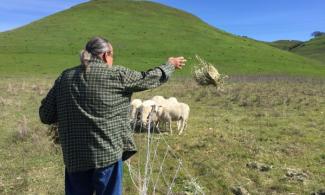
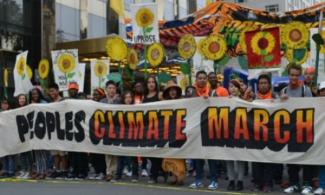
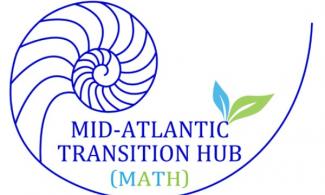

Add new comment